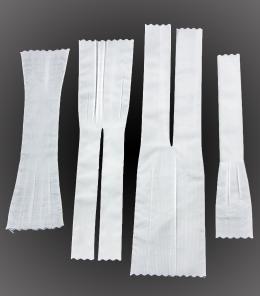These days, medical devices look more like a futuristic movie prop than reality. Made of various metals, plastics and biomedical textiles, improved devices include prosthetics, aortic repair woven tubular and fine flat woven scrims. These textiles are softer, more flexible, stronger, and more versatile than previous available options, which makes them more sustainable in crucial cardiovascular and orthopedic applications.
 Rigid materials and methods are seeing improvements thanks to biomedical textiles. Not only is the physical outcome a benefit of these innovations, but so are the cost efficiency and healthcare outcomes. Bally Ribbon Mills developed a timely, broad product line of biomedical textiles for medical use, contributing to the field’s innovations.
Rigid materials and methods are seeing improvements thanks to biomedical textiles. Not only is the physical outcome a benefit of these innovations, but so are the cost efficiency and healthcare outcomes. Bally Ribbon Mills developed a timely, broad product line of biomedical textiles for medical use, contributing to the field’s innovations.
Within the product line, you can find woven tapes and webbing in either flat fabrics or straight or bifurcated tubular structures, dental, orthopedic and prosthetic biotextiles. Webbing, in particular, offers many life-saving advances in medicine. The first of three ways webbing can save lives is with prosthetic devices.
-
Prosthetic Devices
A prosthetic is any foreign or synthetic material or part that’s purpose is to replace a body part. One type of prosthetic devices is an implant. Permanent or temporary in nature, the implant’s material and characteristics depend on its purpose and environment in which it will be used. These small to large prosthetics can replace body parts, monitor bodily functions, deliver medication or support tissues and organs. Common examples are hip implants, which are permanent, and chemotherapy ports, which are removed after medication is no longer needed.
Medical devices of biomedical textiles are a fairly new technique used for prosthetic implants, and require high standards. These requirements are:
- Porosity — A measure of the density of a woven fabric
- Fiber Size — Determines porosity and implant size
- Toxicity – A measure of when a fiber polymer or fabrication technique needs to be free of contaminants and completely non-toxic, including the fibers
- Bio-Friendliness – A measure of how adaptable the fiber is within the human body. For example, use of biodegradable and bio-stable elements will allow body cells to properly adhere to and subsequently grow on the device.
Though there is a wide variety of uses for biomedical textiles in prosthetics, below are a few of the most common uses in medicine today.
- Soft Tissue Implants — Artificial tendons and skin patches are examples of these. Chemical structure, hydrophilicity, surface roughness, flexibility, electric charge, hydrophobicity and micro heterogeneity are all important characteristics of soft tissue implants that affect tissue growth and cell attachment.
- Hard Tissue Implants — Artificial joints and bones are examples of hard tissue implants. Crucial properties include chemical stability, biocompatibility, strength, and processability. This type of implant is used to stabilize a hard tissue and promote tissue growth around the implant itself.
- Dental Prosthesis — A trip to the dentist for dental prosthetics can relieve pain, enhance speech, improve appearance and prevent disease. Ideally, a biocompatible, bondable material will be used to match the patient’s natural appearance.
- Vascular Devices — Used to replace weakened or blocked cardiovascular system components, vascular implants are used for a variety of reasons. A graft or stent allows for bypass of a blockage to restore circulation. Weaving technology creates anatomically correct straight or branched structures for these procedures. Tightly woven grafts are used to prevent a hemorrhage directly following implantation. Blood compatibility, porosity, re-absorbability, easy tissue growth and defect free weaving to resist clotting are all important factors in this type of procedure.
As you can see, biomedical textiles play a major role in saving and improving lives on a daily basis within complex and simple medical procedures and treatments. There are two more fascinating ways webbing saves lives that we’d like to share with you, and Bally Ribbon Mills is proud to design and produce these necessary textiles.
Check back in two weeks to find out the other two ways these materials can save lives.






